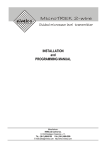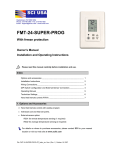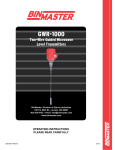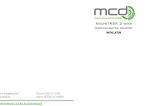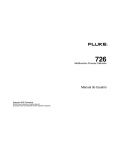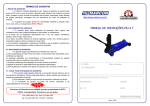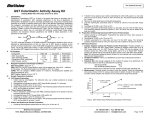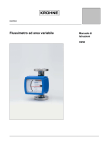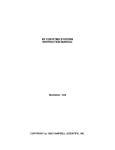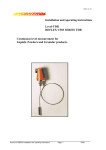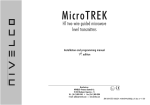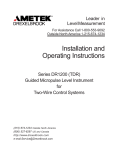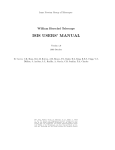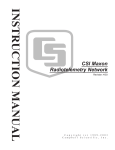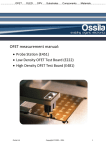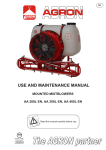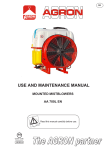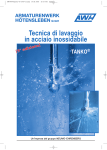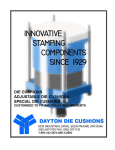Download 2-WIRE
Transcript
© KROHNE 03/2004 7.02229.33.00 GR Installation and Operating Instructions BM 102 MICROFLEX T D R Level gauge 2-WIRE Variable area flowmeters Vortex flowmeters Flow controllers Electromagnetic flowmeters Ultrasonic flowmeters Mass flowmeters Level measuring instruments Communications technology Engineering systems & solutions Switches, counters, displays and recorders Heat metering Pressure and temperature Subject to change without notice. Table of contents 1 1.1 1.2 1.3 1.3.1 1.3.2 1.3.3 1.3.4 1.3.5 Mechanical installation .....................................................................................................5 Handling and storage ..........................................................................................................5 Installation restrictions .........................................................................................................7 Mounting on the tank ...........................................................................................................7 Installation Instructions: General notes................................................................................7 Installation instructions: nozzle ............................................................................................7 Installation instructions: Gauge - all applications .................................................................9 Specific installation instructions: gauge - liquid applications..............................................12 Specific installation instructions: gauge - solid applications...............................................13 2 2.1 2.1.1 2.1.2 2.1.3 2.2 2.2.1 2.2.2 Electrical connections ....................................................................................................16 Electrical installation instructions .......................................................................................16 Wiring general notes..........................................................................................................16 Wiring connections: DIN connector ...................................................................................16 Wiring connections: M16 terminal box...............................................................................17 Power Supply ....................................................................................................................17 Non-hazardous-duty version .............................................................................................17 Hazardous-duty version.....................................................................................................18 3 3.1 3.2 3.3 3.3.1 3.3.2 3.3.3 3.4 User interface...................................................................................................................19 Power-on and start-up .......................................................................................................19 Available user interfaces ...................................................................................................19 Operator control and display .............................................................................................19 PCSTAR 2 Version 2.01 for Windows : basic installation & operating instructions............19 HART® Communicator......................................................................................................21 Local user display (instruments equipped with DIN connectors only)................................22 Fault clearing .....................................................................................................................23 4 4.1 4.2 4.2.1 4.2.2 4.3 Technical data..................................................................................................................26 Technical data ...................................................................................................................26 BM 102 equipment architecture.........................................................................................29 BM 102 mechanical options (by probe type) .....................................................................29 Probe measurement limits .................................................................................................31 Gauge dimensions.............................................................................................................32 2 BM 102 Device description and range of applications The BM 102 MICROFLEX level gauge uses the Time Domain Reflectometry (TDR) measuring principle and two-wire technology for level measurement. It is designed solely for measuring the distance, level, volume and ullage of liquids, pastes, slurries and powders. It can continue to measure the level or distance of the top product and total volume in applications with two or more products. The level measurement data can be displayed and the gauge configured using either a HART Handheld Communicator console (HHC) or a PC work station equipped with PCSTAR 2 software which is supplied as standard with the gauge. Principal gauge components BM 102 housing and probes (non-Ex and Ex versions) 1 2 3 4 5 6 7 8 9 10 11 12 13 14 15 with hightemperature option with raising converter option Nameplate (see next page for details) Cable entry (output and power supply) to wiring compartment Equi-potential bonding system connection (for Ex applications) Flange (process connection onto tank or other suitable mounting) Single cable probe Counterweight (with threaded hole in base for anchoring) Twin cable probe Spacer Chuck (for single cable probes) Turnbuckle (for twin or single cable probes) Threaded process connection (e.g. G1, NPT1, …) Coaxial probe Extension tube for high temperature applications Single rod probe Raising converter: coaxial tube under the process connection (i.e. an inactive length of the probe) for installations with long nozzles or concrete roofs – for single rod and single cable probe versions only BM 102 3 Standard nameplate *eg. VF030415B0112110110100000. The “type code” is defined in the BM 102 Data Sheet. This document is available from your local KROHNE Sales office or in the “Download Centre” on KROHNE’s website http://www.krohne.com/. Items included with supply The scope of supply encompasses, in the version as ordered: • Signal converter with probe in the version ordered. The version is stated on the nameplate. • PCSTAR 2 computer software for data display and gauge configuration. Documentation supplied: Installation & Operating instructions (this manual): Installation, connection, start-up and safety advice in condensed form, but sufficient for most applications. This is supplied as a printed document with the device delivered. Handbook: Detailed user manual and reference book, including how to configure meter parameters available in the user menu and how to perform basic maintenance. This is not shipped with the level meter ordered – it is available in the “Download Centre” on KROHNE’s website http://www.krohne.com/. Supplementary Installation and Operating Instructions BM 102 KEMA 00 ATEX 1101X: Supplementary instructions covering devices to be installed and used in hazardous areas. This document is only supplied with specially approved instruments. This document is available from your local KROHNE Sales office or on the “Download Centre” on KROHNE’s website http://www.krohne.com/. 4 BM 102 Product liability and warranty: The BM 102 TDR level gauge is designed for measuring the distance, level, and volume of liquids, pastes, slurries, powders and cereal products. It may equally measure level, distance and total volume in applications with two or more products. Special codes and regulations apply to its use in hazardous areas : please refer to the BM 102 MICROFLEX KEMA 00 ATEX 1101X Supplementary Installation and Operating Instructions for further information. This document is available from your local KROHNE Sales office or on the “Download Centre” on KROHNE’s website http://www.krohne.com/. Responsibility as to suitability and intended use of these level gauges rests solely with the user. Improper installation and operation of our level gauges may lead to loss of warranty. In addition, the "General conditions of sale", forming the basis of the purchasing contract, are applicable. If you need to return measuring instruments to KROHNE, please note the information given on the last page of these Instructions. KROHNE regrets that they cannot repair or check your device unless it is accompanied by the completed form sheet. The level gauge does not form part of an overfill protection system (as defined for example in WHG: German water resources act) nor is it concerned by the Pressure Equipment Directive (PED) 97/23/EC. 1 Mechanical installation 1.1 Handling and storage To carry: the device will weigh between 3 kg or 7 lb and 12 kg or 25 lb. Carry using both hands to lift the device carefully by the converter housing. If necessary, use lifting gear. No attempt should be made to lift the instrument by its probe. Caution: The probe is a critical gauge component. Do not damage– Handle with care!!! BM 102 5 Avoiding blows When handling the BM 102, avoid hard blows, jolts, impacts, etc. Caution: Fragile electronics Avoid bending (single rod and coaxial probes) Support the probe to avoid bending. Support probe here Avoid cable kinks and fraying Do not coil the cable less than 400 mm or 16 “ in diameter. Cable kinks or fraying will cause measurement errors. Storage temperature Store within the given storage temperature limits. 6 BM 102 1.2 Installation restrictions Hazardous-duty systems (Ex, FM,…) • Refer to the BM 102 MICROFLEX KEMA 00 ATEX 1101X Supplementary Installation and Operating Instructions supplementary instructions for further information on installing gauges approved for use in hazardous locations. This document is available from your local KROHNE Sales office or on the “Download Centre” on KROHNE’s website http://www.krohne.com/. • Check that the flange, gasket and probe materials are compatible with the product. Read the information given on the converter nameplate, the flange markings and specifications in the approval certificates. 1.3 Mounting on the tank 1.3.1 Installation Instructions: General notes The fitter should give some thought to tank fittings and tank shape. • Nozzle position in relation to the tank walls and other objects inside the tanks (Warning : this free area will depend on the probe type selected: refer to later on in this section) • Type of tank roof , i.e. floating, concrete, integral, etc; and base, i.e. conical, etc. Whenever working on an installation, remember to: • Disconnect the power supply before starting work. • Drain the tank completely before installing the device (not applicable to cable probes). 1.3.2 Installation instructions: nozzle Threaded process connections Nozzle height Recommendation Do not fit a nozzle longer than its diameter , especially for single probes and powder applications The simplest and most economic way is to mount the BM 102 directly on the tank with a GAS or NPT threaded connection. h ≤ Ød , where h = nozzle height and d = nozzle diameter Contact KROHNE if this relationship cannot be respected. BM 102 7 Nozzles extending into tank Caution: Do not use nozzles that extend into the tank. This will disturb the electromagnetic emitted pulse and the measurement. Installation of two devices If two devices are to be used on the same tank, these should be mounted a distance of at least 2 m or 6 ¾ ft away from each other. If not, interferences from the electromagnetic (EM) fields generated by both instruments may cause measurement errors. Not applicable to coaxial probes - the outer shell of the probe contains the EM field: no minimum distance required. Process connection For the gauge to make accurate measurements: • The tank process connection must be level. • Ensure a good fit with the gauge process connection • The tank roof should not deform under the weight of the gauge 8 BM 102 Process connection and entry pipe Caution: Do not put the nozzle close to the entry pipe. Pouring the product directly onto the probe will give false readings. Install deflector plate if impossible to distance gauge from entry pipe. Stilling wells Tanks with floating roofs for petro-chemical applications: use a stilling well. 1 Stilling well 2 Tank 3 Floating roof 4 Product (petroleum applications) 5 Well fixed to tank base (no roof deformation) 6 Sediment 1.3.3 Installation instructions: Gauge - all applications BM102 gauges are designed to be mounted on a suitable process connection on a tank or sump. Install the gauge using two people to avoid damaging the probe. Support the housing and the probe. BM 102 9 Installation of level meters with single or twin cable probes 1 2 Caution : Do not over-bend probe! Inserting the probe: hold more than one metre above the opening to avoid cable bending. Probes: entanglement, straightness and tank bottom clearance Rigid section length of single and twin cable probes Cable diameter Rigid section length Single cable Ø4mm/0.15” 40mm or 1½” Ø4mm/0.15” 200mm or 8” Twin cable Ø4mm/0.15” 40mm or 1½” • • Cable probes must be straight once inserted into the tank. They must also be far from other objects (e.g. mixers) to avoid entanglement. In order to maintain the gauge’s operating characteristics, it is recommended to avoid touching the tank bottom with the counterweights (for cable probes) or probe end (other types). Objects (discontinuities) inside the tank that influence the probe’s EM (electromagnetic) field Install the gauge far from protruding objects such as: • Heating tubes, • Sudden changes in tank cross-section, • Tank wall reinforcements and beams, • Weld lines and dip-stick pipes, etc... TDR gauges generate electromagnetic (EM) fields when a measurement pulse is emitted. This field is affected by any nearby discontinuities and these will weaken and potentially block the emitted pulse. A minimum distance is recommended depending on the probe type to be installed. See the table on the next page for recommended free space dimensions. Alternatively, the fitter may use a reference chamber or stilling well. However, the chamber walls must be smooth (i.e. no visible weld lines), straight and vertical to maintain the pulse strength and gauge accuracy. 10 BM 102 For clean applications only : Coaxial (type 3) probes may be used close to or touching objects or walls as the EM field generated by the probe is contained within the probe’s outer sheath (refer also to the EM field sizes/free area given in the figures on the next page). 1 Agitator 2 Support beam perpendicular to the pulse direction 3 Abrupt changes in tank cross section 4 Heating tubes 5 Alternative solution: reference chamber -electromagnetic field is contained within chamber 6 Gauge electromagnetic field: Any intruding metallic object will be detected in this zone if perpendicular to the emitted pulse direction. = Do not fit the gauge near to these objects. Recommended minimum distance of probe from objects inside the tank Probe Type Minimum free space Single (types 1,2 and 6) 300 mm or 12” Twin (type 4) 100 mm or 4” Coaxial (type 3) 0 mm or 0” Electromagnetic field shape around probe, by type (not to scale) Single (types 1,2 and 6) Twin (type 4) Coaxial (type 3) No beam angle for any probe type. BM 102 11 Avoid direct solar radiation Fit a sunshade on the gauge for open-air installations: this is either supplied on demand by KROHNE or provided by the customer. The ambient temperature limits of the gauge are given below. 1.3.4 Specific installation instructions: gauge - liquid applications Probe bending in agitated products: recommended solutions 1 Agitator 2 Turnbuckle for anchoring probe to tank bottom 3 Bypass chamber 4 Counterweight (centred on request) Mounting on a reference vessel or still well is ideal. To ensure that the probe does not come into contact with the tank wall, the end of the probe should be fixed to the bottom of the chamber or centred. 12 BM 102 Fastening the probe to the tank bottom The flexible probe can be fastened with a chuck (ring) or a fastening device to the tank bottom: Chuck (ring) Turnbuckle for Ø8 mm cable probes Turnbuckle for Ø4 mm cable probes 1.3.5 Specific installation instructions: gauge - solid applications False readings: 1 Do not let probe touch the side of the nozzle BM 102 13 Conical silo nozzles, False readings and traction on the cable probes Caution 1 High traction forces : We recommend that the probe should not be anchored to avoid excessive traction loads on the cable. 2 Bending and traction: Position the connection on the roof at ½ radius of the tank and with minimum nozzle height. This will avoid damage due to bending and traction during emptying. Traction forces during emptying cycles for powder applications Traction load is dependent upon the height and shape of the tank, product particle size & density, and the rate at which the tank is emptied. The table below gives the load at which cable probes will support. Cable maximum design load, traction Probe Single cable Ø8 mm or Ø0.3” Maximum Load 3.5 T or 7700 lb Traction on cable according to product (approximate value in metric tons) Probe Length / m (ft) Probe used Material 10 (33) 20 (65.5) 24 (79) Single cable Ø8mm or Cement 1.0 T or 2200 lb 2.0 T or 4410 lb 2.4 T or 5290 lb Ø0.3” Flyash 0.5 T or 1100 lb 1.0 T or 2200 lb 1.2 T or 2650 lb 14 BM 102 Electro static discharge (E.S.D.) BM 102 non-Ex and Ex gauge electronics are shielded up to 4kV against E.S.D.. Note: E.S.D. cannot be solved by BM 102 E.S.D. protection. It is the customer’s responsibility to avoid E.S.D. by grounding the tank, product and probe installation. 1 Danger of injury 2 The probe may receive an electrostatic discharge during operation; earth the probe by pushing it against tank wall with a suitably isolated tool just before touching it to avoid receiving a shock. Earth the entry pipe and product. Product deposits on the nozzle and probe Product build-up can occur under the nozzle: this may weaken the pulse. Avoid cavities that permit the build-up of deposits. Tank roof deformation Tank roofs should support loads of at least 3.5 tonnes or 7700lb for gauge installations using Ø8mm or 0.3” (type 6) single cable probes. BM 102 15 2 Electrical connections 2.1 Electrical installation instructions 2.1.1 Wiring general notes Connection to power is effected at the plug connector in the signal converter. Two wiring compartments are available: DIN connector or M16 terminal box. Observe applicable rules and regulations for cable connection: VDE 165 or equivalent national regulations. Always disconnect from power supply before opening wiring compartment. This is not mandatory for Exi applications. Hazardous-duty systems Only certified intrinsically safe equipment may be connected to the BM 102 in hazardous areas. Please refer to the BM 102 MICROFLEX KEMA 00ATEX1101 X Supplementary Installation and Operating Instructions for further information. This document is available from your local KROHNE Sales office or on the “Download Centre” on KROHNE’s website http://www.krohne.com/. 2.1.2 Wiring connections: DIN connector Terminals: Cable entry: Shielding: Signal cable: 3 poles and 1 x ground. Wire cross-section: max. 1.5 mm² (AWG 16) 1 x PG11, cable diameter: 8 … 10 mm or 0.31” … 0.39”, IP 65 or NEMA4 do not connect to the DIN connector. no shielding required 1 2 3 4 5 Detach screw P and remove plug from signal converter. Separate part N from part R by inserting the flat tip of a screwdriver into gap F. Connect current loop to terminals 1 and 2 (any polarity). Use ferrules to protect cable ends. Terminals 3 and E are not connected. Fit parts N and R together again. Fit gasket, re-insert connector plug R on the signal converter, and replace screw P. Caution Grounding terminal E is not connected to the housing of the signal converter or to the device flange. To avoid ground current loops, the cable shielding may not be connected at both ends. Hazardous-duty systems When used in hazardous areas, only one intrinsically safe power supply may be connected to terminals 1 and 2. Ground terminal E and terminal 3 are not connected. 16 BM 102 2.1.3 Wiring connections: M16 terminal box Power terminals: Cable entry: Shielding: Wire cross-section: max. 1.5 mm² (AWG 16) 1 x M16 x 1.5, cable diameter: 3.5 … 8 mm or 0.14” … 0.31”, IP65 or NEMA4. For USA: ½” NPT conduit connection Do not connect shielding to the terminal compartment. Hazardous-duty systems When used in hazardous areas, only one intrinsically safe power supply may be connected to terminals 1 and 2. Ground terminal E is not to be connected. Caution Ground terminal, E, is not connected to the signal converter housing or to the device flange. To avoid ground current loops, the cable shielding may not be connected at both ends. 1 2 3 2.2 Detach the 4 screws, T, and remove cover from terminal compartment. Connect the cable ends, fitted with ferrules, to the power terminal, U (not polarity sensitive). Shut the terminal compartment. Power Supply 2.2.1 Non-hazardous-duty version Power supply Rated voltage: Max. voltage (Uinput max): Min. voltage (Uinput min): 24 V DC 35 V DC ’Ex’ = 28 V DC dependent on load impedance, see graph below A supply voltage above 35 V DC can cause irreparable damage to the signal converter. Also, power supply voltages above the specified max. values and below the specified min. values can lead to faulty measurements or to a device reset. BM 102 17 Load impedance Rloop Loop resistance, Rloop Min. Rloop Max. Rloop RHART resistance for HART® communication RHART + Rcable + Rammeter 0 ohms 750 ohms 250 ohms (recommended) Line A = minimum voltage at the BM 102 terminals Line B = voltage drop caused by a 250 ohm loop resistance Example for calculating the required power supply: The voltage drop is tested at 22 mA. U power min. 22 = 22 mA x load impedance + Uinput min. 22 U power min. 22 = 22 mA x 250 ohms + 10 V = 5.5 V + 10 V = 15.5 V In order to cover the whole current range, the voltage drop must also be tested at 4 mA: U power min. 4 = 4 mA x load impedance + Uinput min. 4 U power min. 4 = 4 mA x 250 ohms + 18 V = 1 V + 18 V = 19 V At a load impedance of 250 ohms a power supply voltage of 19 V is sufficient to energize the device current range of 4 to 20 mA. 2.2.2 Hazardous-duty version The certified device may only be used with other ’Ex’ certified equipment. Refer to the BM 102 MICROFLEX KEMA 00 ATEX 1101X Supplementary Installation and Operating Instructions supplementary instructions for further information on installing gauges approved for use in hazardous locations. This document is available from your local KROHNE Sales office or on the “Download Centre” on KROHNE’s website http://www.krohne.com/. 18 BM 102 3 User interface 3.1 Power-on and start-up The BM 102 is pre-configured in accordance to customer order specifications and measurements can be made immediately. A warm-up time of less than 23 seconds should be allowed for once connected and the power is switched on. 3.2 Available user interfaces Measurements may be taken using either: • PC STAR 2 software • HART® Handheld Communicator (HHC) • DA 06 local indicator 3.3 Included as standard with the instrument. The basic installation & operating instructions are presented in section 3.3.1 (requires PC workstation). Sold separately. Automatic recognition of the instrument when connected. A list of HHCaccessible parameters is given in the BM 102 Handbook. Sold as an option for devices equipped with DIN connectors. For displaying readings only. Refer to section 3.3.3 for technical data. Operator control and display You can configure the device by way of the PC-STAR 2 software or the HHC. Refer to the BM 102 Handbook, section 3.3 for more details. This document is available from your local KROHNE Sales office or in the “Download Centre” on KROHNE’s website http://www.krohne.com/. 3.3.1 PCSTAR 2 Version 2.01 for Windows : basic installation & operating instructions Software description PC STAR 2 is a Windows program that permits clear and concise display of data and configuration of the BM 102 from a remote location. The program is available in English, German or French. PC-STAR 2 system requirements • • • • • • • PC with at least 486 processor 75 MHz, recommended: Pentium 120 MHz or higher Microsoft Windows 9x, Me, 2000, NT and XP Min. 16 MB main memory (RAM) Min. 3 MB available hard disk storage 3 ½ “ Floppy disk drive Mouse or other pointing device Serial RS232 port BM 102 19 Installing and connecting the PCSTAR 2 software 1. Connect the HART® adapter (not included in supply) through a load impedance of 350 ohms maximum (for hazardous-duty purposes, fix to the non-intrinsically safe side of the repeater power supply unit) and plug it into a serial interface on your PC. The repeater power supply ® unit must have HART capability. 2. Installing the program: Access the files on the floppy disk supplied with the instrument and execute the file "setup.exe" and follow the instructions on the screen. 3. Running the program: once the program is installed, execute the program. 4. Define device interface: type F4 or left-click on “F4-Serial” at the bottom of the screen - to define the interface to which the device is to be connected. Serial Port BM102 Address Device Identifier Initial baud rate RTS state 5. 6. • • • • • • • The serial port allows the user to select a free serial port (COM 1 to 4) on the computer. Type the “Address” that you have given a gauge (a value between 0 and 15) and press ENTER or OK. This will select the required device. If you are in a point to point network leave the box at its default value (-1). Device Identifier refers to the “Device number” given in User Function No. 1.4.4. Transmission rate of data. Has a default value of 1200 bd. Trials should be run to find the optimum operating conditions. The RTS state depends on the type of RS232 converter used. For RS232<>HARTTM(i.e. VIATOR from MACTEK) use inversed RTS state. On-line connection with the gauge: Press F2 or left-click on “F2-Connection” to set up the connection with the device - the configuration parameters are automatically loaded into the gauge. After the connection has been established, the following screen is shown. This will show the current status of the tank. No further configuration should be necessary. The following functions are available on the screen and are discussed further in the BM 102 Handbook*: F2 – Device configuration: a summary of the parameters are given on the next page, F7 – Oscilloscope function: have all reflections occurring at the probe displayed, F11 – Dynamic/on-line device configuration, F4 – View and record all information during operation, F6 – Trend: observe the level trend since start of the program, F8 – Marker: the status of the device And F10 – make printouts (screen shots). Special note: F8 – Markers Menu Displays a real-time evolving graph of error markers which are either displayed as active (value 1) or inactive (value 0). Refer to section 3.4 “Fault clearing” for corrective procedures when the markers shown above are active. *This document is available from your local KROHNE Sales office or on the “Download Centre” on KROHNE’s website http://www.krohne.com/. 20 BM 102 ® 3.3.2 HART Communicator Display and configuration can also be carried out via a HART® communicator. Operator control via this unit is described in detail in the operating instructions supplied with the HHC. Basic operating instructions for taking measurements Communicator layout 1 2 3 4 Two-pin jack for loop connectors LCD Function keys (F1 … F4) Action keys On/off LEFT Arrow UP Arrow DOWN Arrow n/a RIGHT Arrow Other functions:LEFT Arrow: Previous menu key RIGHT Arrow: Select key Displaying readings Use the UP and DOWN arrows to move to the correct line and then select with the RIGHT Arrow. 1 HART Communicator 1 Offline 2 → Online 3 Frequency Device 4 Utility F1 3 F2 F3 Main menu 2 BM102:00000 01 Online 1 → <Process Var.> 2 <Config./Test> 3 <Access/Rights> 4 <Watch status> 5 <HART Variables> SAVE F1 F2 F3 F4 Online menu 4 BM102:00000 01 ♥ <Measurements> 1 → <Lvl> 878.00 mm 2 <Dist> 121.00 mm F4 BM102:00000 01 <Process Var.> 1 → <Measurements> 2 <Input/Outputs> SAVE HOME F1 F2 F3 F4 Measurement & input and output functions menu BM 102 HELP SAVE HOME F1 F2 F3 F4 Measurement display function 21 3.3.3 Local user display (instruments equipped with DIN connectors only) The BM 102 local indicator is available as an option. This fits onto the BM 102’s standard DIN connector. Data can be read from an LED display. The gauge configuration menu cannot be accessed with this option. For non-Ex applications only. Please refer to the DA 06 Supplementary instruction manual for further information. This is available on request from KROHNE. Technical data: DA 06 Plug-in Display (non-Ex) DA 06 Plug-in display (supplied separately) Measuring range: Display: Accuracy: Adjustable parameters: Min. / max. value memory: Housing: Protection: Temperature range (ambient) Electronic system: Storage: Electrical connection: Input signal Max. voltage drop across unit Switching output1 CE conformity 22 DA 06 Plug-in display mounted on a BM 102 -1999 to 9999 digits (min. and max. values user defined) 4-digit, 7.6 mm or 0.3” high, red LED display, display housing can be turned through 330° 0.1 % +/- 1 digit Scaling, decimal point, attenuation, switching point, delay Displays the minimum and maximum values recorded during operation. Plastic, PA 6.6 / polycarbonate 47mm X 47mm x 68 mm or 1.9” x 1.9” x 2.7” (h x w x d), housing can be turned by 300° IP 65 (EN 60529) or NEMA4 0°C … +60°C or 32°F … 140°F -30°C … +80°C or -22°F … 176°F Adapter for plug as per DIN 43650 4…20 mA / 2-wire Approximately 6 V DC open collector (PNP), max. 125 mA, on and off delay: 0 to 100 seconds, temperature influence: 0.1% / 10 K EN 50081-1 and EN 50082-2 BM 102 3.4 Fault clearing Event Error messages “Tank full” status marker on*, reading frozen at max. or min. value “Tank empty” status marker on*, reading frozen at max. or min. value “Tank full” and “Level lost” status marker on*, reading frozen at max. or min. value “Level lost” status marker on*, reading is frozen “Reference not found” status marker on* “Level lost” and “Reference not found” status markers on*, reading frozen Fault Action No fault. The level has reached (and possibly risen above) the top configured measurement limit and is either displaying the maximum (when measuring level) or minimum (when measuring distance) output. No fault. The level has entered the gauge’s bottom dead zone and can no longer detect a return signal. Either the maximum (when measuring distance) or minimum (when measuring level) output is displayed. The level has entered the gauge’s top dead zone and can no longer detect a return signal. The instrument has lost the level signal, has searched but not yet found the return pulse. This may occur if the pulse has dropped below the threshold. Parasite signals from the flange or obstructions in the tank may render the gauge unable to identify the correct signal. None. Measurements should be normal once the level is in the configured measurement range. Occurs when there is a problem with the time base on the HF board. The probe has received an electrostatic discharge. None. Measurements should be normal once the level is in the configured measurement range. Empty the tank below the top measurement range limit and check the measurement. Empty tank below maximum level or fill tank above the minimum level and check the measurement. If the signal is not detected then modify the control threshold manually as shown in sections 3.5.2 and 8.4.2 of the BM 102 Handbook using the oscilloscope (F7) and dynamic configuration (F11) windows in PCSTAR 2. Please contact your local KROHNE Service Centre**. The gauge will search for the level again and resume readings. If the reading remains frozen then the signal converter may have been damaged by ESD and may need replacing. Please contact your local KROHNE Service Centre**. *Gauge connected to PC-STAR 2 software or HART Handheld Controller (HHC) with Marker status window (F8) or “Watch status” (Menu 4.0) list displayed respectively. **A list of contact details for every KROHNE service centre is supplied on the last page of these instructions. BM 102 23 Event “Flange not found” status marker on* “Delay out of limits” status marker on*, reading is frozen. “Negative voltage error” status marker on* “VC01 voltage error ” status marker on* “VC02 voltage error” status marker on* “Reprogramming FPGA” status marker on* General operation The BM 102 indicates an incorrect level value. Instrument is not accurate when there are two or more phases in the tank. Fault The signal converter has been incorrectly configured to measure with a cable or rod probe when it is equipped with a coaxial probe. This may also due to installation on a long nozzle which has the effect of attenuating the flange pulse. The emitted pulse has not been detected. The gauge will not work until it has been found. Occurs when there is a problem with the time base on the HF board. Action Contact KROHNE for the corrective procedure**. The BM 102 measures a nonvalid reflection. Check the tank for obstructions and verify that the probe is clean. When the indicated level is close to the nozzle, increase the detection delay and the dead zone with the same ratio or increase the threshold level if the full measurement range is essential. In any case, use the PCSTAR 2 oscilloscope function,F7, to visualise and to analyse the application. The threshold level must be adjusted so that it masks the disturbances. Very large pulses along the measurement signal (same amplitude as the emitted pulse) can be caused by a probe touching the nozzle or tank side (section 1.3.5) Contact KROHNE** for the corrective procedure or refer to the Service Manual. Check that Factory Menu function 1.1.3: Application Type is set to “2 liquids, 1 level”. Check also that there is a layer of more than 100 mm of top product above the bottom product. The instrument may be incorrectly configured for this type of application i.e. it is measuring the interface instead of the level. The signal converter may need replacing. Please contact your local KROHNE Service Centre**. Please contact your local KROHNE Service Centre**. *Gauge connected to PC-STAR 2 software or HART Handheld Controller (HHC) with Marker status window (F8) or “Watch status” list (Menu 4.0) displayed respectively. **KROHNE service centre contact details are supplied on the last page of these instructions. 24 BM 102 Event Fault Electrical Connections and Communication Output Current Output value No power supply < 4 mA. Connection of the device is incorrect. The calibration of the current output is incorrect. Reads 22 mA. An error has occurred. The device is in its start-up phase. The value at the current output does not correspond to the value at the display ® (PC STAR 2 or HART communicator). The current output settings are incorrect. Data communication via the digital interface is not working. The BM 102 is in its start up phase, wait 50 seconds and try again. The communication parameters of the computer are set incorrectly. Bad connection to the interface. Current output value is < 4 mA. Current output value is = 22 mA Action Check the power supply. Check the connection between the device and the power supply. Execute the calibration if you have authorized access or contact KROHNE Service Centre**. This happens in case the range 420 mA / error 22 mA is selected. Check the status of the device by selecting the marker window (F8) or enter the Watch status (4.0) ® menu of the HART communicator. Wait 50 seconds. If the current value drops to a value between 4 and 20 mA, and goes immediately back to 22 mA, contact your KROHNE Service Centre**. Check the current loop and the connections. Configure output as described in Sect. 3.3.3 (user submenu 1.3) of the BM 102 Handbook* - also try adjusting the threshold using F11-Dynamic Configuration function (PCSTAR 2) or menu 2.1.5.1.0 – Threshold (HHC). Check computer setting (address/device number). Check connection. Contact your KROHNE Service Centre**. If problem persists then contact your KROHNE Service Centre**. *This document is available from your local KROHNE Sales office or on the “Download Centre” on KROHNE’s website http://www.krohne.com/. ** KROHNE service centre contact details are supplied on the last page of these instructions. BM 102 25 4 Technical data 4.1 Technical data Application Range of applications Continuous level measurement of liquids, solids and powders Function and system design Measuring principle Equipment architecture Time domain reflectometry using a direct mode of measurement See section 4.2 Input Measured variable Measurement range Blocking Distance (dead zone) Output Analogue Digital Digital, Ex ia Signal on alarm Distance (between the reference point – gauge flange facing – and the product surface), level, liquid interface & volume Variable according to probe type, see Equipment architecture, section 4.2.1 Minimum tank height = 0.15 m or 0.5 ft. Variable according to probe type, see probe measurement limits, section 4.2.2 4 … 20 mA, passive output Load Passive outputs 750 Ω maximum Error signal 22 mA Resolution ± 3 µA ® HART , passive output ® HART , passive intrinsically-safe output ® Status markers via PC STAR 2 or HART controller (HHC) Performance characteristics Reference operating conditions Ambient temperature +20°C ± 5°C or +68°F ± 9°F Ambient air pressure 1013 mbar abs. ± 20 mbar or 14.69 psig ± 0.29 psi Relative air humidity 60% ± 15% Reference target - coaxial probe : water surface - single probe : Ø 0.8 m or Ø 31.5 in. metal plate - twin probe : metal block “short circuit” Free space diameter > 300 mm or > 11.81” * Distance to obstruction > 1 m or > 3.3 ft. Accuracy Level measurement Liquids when probe length, L ≤ 15 m or 50 ft. ± 15 mm or 0.6” outside the dead zone Optional: ± 5 mm or 0.2” Liquids when probe length, L > 15 m or 50 ft. ± 15 mm or 0.6” ± 0.1% of the measured distance Optional: ± 0.05% of the measured distance Solids (powders) ± 20 mm or 0.8” with 4 … 20 mA current output ± 0.01% of the measured distance * not for coaxial probe. 26 BM 102 Repeatability Hysteresis Resolution Transient recovery time ± 2 mm or 0.08” none ± 1 mm or 0.04” The transient recovery time to 1% deviation from the final value amounts to approximately 4.6 times the programmed time constant. However, the transient recovery time may differ if changes in level are very rapid. Start-up time ≤ 23 seconds Long term drift This is within the specified error of measurement. Allow for thermal expansion coefficient in the case of liquids. Organic liquids: 0.15%/K Influence of ambient temperature ® current output HART : typically 70 ppm/K measured value 25 ppm approx. (max. deviation over total measurement range) atmosphere -1 ppm/K (above the liquid product) digital No influence on measured value due to regular self-calibration Environment Ambient temperature Storage temperature Protection Shock resistance Vibration endurance limit -30°C … +60°C or -20°F … +140°F*** -40°C … +80°C or -40°F … +176°F IP 65 / NEMA 4 – 4X The device withstands the impact test in conformity with EN 61010, Section 8.2 with 0.5 J energy. IEC 68-2-6 and prEN 50178 (10-57Hz: 0.075 mm / 57-150 Hz: 1 G). Power supply Standard Hazardous-duty (Ex, FM, …) Range 24 V DC, ≤ 28 V DC 18 … 35 V DC Process Process temperature, product Process temperature, flange Process pressure, standard -30°C … +200°C or -22°F … +392°F * ** -30°C … +90°C or -22°F … +194°F*, option +200°C or 390°F** -1 … 16 bar abs. or -14.5 … 232 psig***; max. 40 bar or 580 psig at 20°C or 45°F*** Dielectric constant εr of product measured: probe type limits Coaxial (type 3) εr ≥ 1.4 Twin probe (type 4) εr ≥ 1.8 Single probes (types 1, 2 & 6) εr ≥ 2.1 Human interface Communication, standard Operator control and data display via PC using PCSTAR 2 software or HART® handheld communicator Point-to-point 1 gauge connected to a PC or HHC Multi-drop Up to 5 gauges connected to a PC or HHC * see BM 102 MICROFLEX KEMA 00ATEX1101X Supplementary Installation and Operating Instructions for Ex values (temperature classes) ** higher or lower temperatures on request (non-Ex) *** Subject to the process temperature and the mechanical properties of the process connection BM 102 27 Construction materials Housing Probe Gasket Spacers (on twin probes) Aluminium with epoxy coating Refer to section 4.2.1: BM 102 mechanical options Viton, optionally Kalrez 6375 Refer to section 4.2.1: BM 102 mechanical options Weight Housing Single rod Ø8mm or Ø0.3” Single cable Ø4mm or Ø0.15” Twin cable Ø4mm or Ø0.15” Single cable Ø8mm or Ø0.3” Coaxial Ø28mm or Ø1.1” 2 kg or 4.4 lb 0.41 kg/m or 0.28 lb/ft 0,12 kg/m or 0.08 lb/ft 0.24 kg/m or 0.16 lb/ft 0.41 kg/m or 0.28 lb/ft 1,3 kg/m or 0.87 lb/ft Standards Electromagnetic compatibility directives followed for EU countries Other EU directives The level gauge satisfies the protection requirements of : Electromagnetic compatibility Directive 89/336/EEC in conjunction with EN 61326-1(A1&A2) and EN 61000-6-2 standards. It also respects the NAMUR NE 21/98 standard. Protection against EMC emissions is only guaranteed when the device is used in metal tanks (except when the device is equipped with coaxial probes). Low voltage electrical equipment Directive 73/23/EEC modified by Directive 93/68/EEC (art.13) in conjunction with the EN 61010-1 standard. ATEX* Directive 94/9/EC in conjunction with EN 50014, EN 50020 and EN 50284 standards. Refer to the BM 102 MICROFLEX KEMA 00 ATEX 1101X Supplementary Installation and Operating Instructions for further information. Approvals ATEX* KEMA 00 ATEX 1101 X Factory Mutual Research* Project ID 3009543 CSA* Project 1183965 (Edition 1) (KEMA: 2007223.00) II 1 G or II 1/2 D T 100 °C EEx ia IIC T6 … T3 or EEx ia IIB T6 … T3 FM Class I, Div. 1, Gr. A, B, C, D and Class II, III, Gr. E, F, G FM Class I Zone 0 AEx ia IIC T4 resp. AEx ia IIC T6 Class I, Div. A, B, C and D: Class II, Div. E, F and G; Class III; Ambient temperature -30°C … +60°C or -20°F … +140°F; max. product pressure 4000 kPa (580 psi). * only approved if requested in customer order. 28 BM 102 BM 102 SS 316 / 316L Probe material Liquid * gauge with flange connection SS 316L Hastelloy C276 DN50 PN 25/40 2” ANSI 150 lbs 2” G / 2” NPT** 1.8 Ø200 mm or Ø8” ≤ 24 m or 79 ft. Minimum process DN50 PN 25/40 connection 2” ANSI 150 lbs 1” G / 1” NPT 1.4 Ø0 mm or Ø0 “ Free area (no obstructions or discontinuities) Minimum dielectric constant, εr ≤ 6 m or 20 ft. Range, max. Level SS 316 / 316L DN50 PN 25/40 2” ANSI 150 lbs 1½” G / 1½” NPT 2.1 Ø600 mm or Ø4” ≤ 24 m or 79 ft. Single flexible cable with counterweight. Single cable Ø8 mm or 0.3” (Type 6) *** on request Powder Hastelloy C276 PVDF coated (non-Ex)* PVC coated (non-Ex)* SS 316L DN50 PN 25/40 2” ANSI 150 lbs 1” G / 1” NPT 2.1 Ø600 mm or Ø24” ≤ 3 m or 10 ft.** Single rigid rod. Single rod Ø8 mm or 0.3” (Type 1) ** higher on request SS 316 / 316L Hastelloy C22 SS 316 FEP coated DN50 PN 25/40 2” ANSI 150 lbs 1” G / 1” NPT 2.1 Ø600 mm or Ø24” ≤ 24 m or 79 ft. Single inner conductor Two flexible SS316 Single flexible cable with protective tube. cables with spacers with countrerweight. interspersed along its length, with short circuit and counterweight. Description Single cable Ø4 mm or 0.15” (Type 2) Coaxial Øext. 28 mm Twin cable Ø4 mm or 0.15” (Type 4) or 1.1” (Type 3) Probe (Type code) Liquid / Liquid Gas applications 4.2 4.2.1 BM 102 mechanical options (by probe type) BM 102 equipment architecture 29 30 BM 102 ** higher on request None Counterweight (dimensions in mm) Gauge illiustration PTFE (if length > 1.5 m or 5 ft). Spacer material *** on request Ø45 x 60 (316L) Turnbuckle (316L) FEP moulded onto the cable. Coaxial Øext. 28 mm Twin cable Ø4 mm or 1.1” (Type 3) or 0.15” (Type 4) Probe (Type code) Ø25 x 100 (316L) Ø25 x 100 (HC22) Ø25 x 100 (HC276) Chuck (316L) Turnbuckle (316L) No spacer. Single cable Ø4 mm or 0.15” (Type 2) Liquid / Liquid Gas applications None No spacer. Single rod Ø8 mm or 0.3” (Type 1) Powder Ø12 x 100 (316L), where L1 > 10m/33ft Ø45 x 245 (316L), where L1 < 10m/33ft Turnbuckle (316L)*** Without*** No spacer. Single cable Ø8 mm or 0.3” (Type 6) 4.2.2 Probe measurement limits * Displayed level and distance values displayed will depend on how and at what level the minimum and maximum gauge outputs have been configured. Probe type Probe measurement limits Top dead zone, Bottom dead A1 zone, A2 εr=80* εr=80* 300mm or 12” 20mm or 0.8” 300mm or 12” 20mm or 0.8” Top dead zone, A1 εr=2.4* 400mm or 15¾” 400mm or 15¾” Single rod (type 1) Single cable Ø4mm or Ø0.15” (type 2) Coaxial (type 3) 0mm or 0” 10mm or 0.4” 0mm or 0” Twin cable Ø4mm 150mm or 6” 20mm or 0.8” 300mm or 12” or Ø0.15” (type 4) Single cable Ø8mm 300mm or 12” 20mm or 0.8” 400mm or 15¾” or Ø3” (type 6) * The dielectric constant εr of water is 80. The dielectric constant εr of oil is 2.4. Bottom dead zone, A2 εr=2.4* 100mm or 4” 100mm or 4” 100mm or 4” 100mm or 4” 100mm or 4” Note: The default factory setting for A1 is 400 mm or 15 ¾”, except for the coaxial probe (0 mm or 0”). Please consult KROHNE if you wish to reduce the size of the programmed top dead zone, A1. If the device is mounted on a tank fitting (e.g. a nozzle), include the height of the tank fitting in the programmed dead zone. BM 102 31 4.3 Gauge dimensions The drawing below illustrates standard gauge configurations and overall dimensions. Housing Standard, M16 terminal box* with flange Standard, DIN connector** with threaded connection High temperature version With inactive length*** Probe 3: Coaxial Ø 28 (1.1) 4: Twin cable Ø 4 (0.15) 2: Single cable Ø 4 (0.15) 1: Single rod Ø 8 (0.3) 6: Single cable Ø 8 (0.3) Standard counterweight None Ø45x60 Ø25x100 None Ø12x100 (ؽx4)**** or (Ø1¾x2½ ) (Ø1x4) Ø45x245 (ؽx9¾)***** Size of threaded hole in base of counterweight for anchoring None M8 M8 None M8 Dimensions in mm (inches) *with a cable fitting M16X1.5 Ø3.5 … Ø8 **with a cable fitting PG11 Ø8…Ø10 DIN43650-A *** the inactive length (i.e. a non-active extension at the top of the probe) may be supplied with the following standard lengths : 100 mm or 4”, 200 mm or 8”, 300 mm or 12”, 400 mm or 16”, 500 mm or 20” and 1 m or 40“ – for single cable and single rod probe versions only. **** where L > 10m or > 33ft ***** where L < 10m or < 33ft L = ordered probe length 32 BM 102 Returning a device for testing or repair to KROHNE Your instrument has been carefully manufactured and tested. If installed and operated in accordance with these operating instructions, it will rarely present any problems. Should you nevertheless need to return an instrument for inspection or repair, please pay strict attention to the following points. Due to statutory regulations on environmental protection and safeguarding the health and safety of our personnel, KROHNE may only handle, test and repair returned devices that have been in contact with products without risk to personnel and environment. This means that KROHNE can only service your instrument if it is accompanied by the following certificate confirming that the instrument is safe to handle. If the instrument has been operated with toxic, caustic, flammable or water-endangering products, you are kindly requested: • to check and ensure, if necessary by rinsing or neutralizing, that all cavities are free from such dangerous substances, • to enclose a certificate with the level gauge conforming that it is safe to handle and stating the product used. We cannot service your instrument unless accompanied by such a certificate. Specimen certificate Company: Address: Department: Name: Tel. No.: Fax No.: The enclosed level gauge Type: KROHNE Order No. or Serial No.: has been operated with the following process liquid: Because this liquid is water-hazardous toxic caustic flammable we have checked that all cavities in the instrument are free from such substances flushed out and neutralized all cavities in the device We confirm that there is no risk to humans or environment through any residual liquid contained in the instrument. Date: Signature: Company stamp: BM 102 33


































